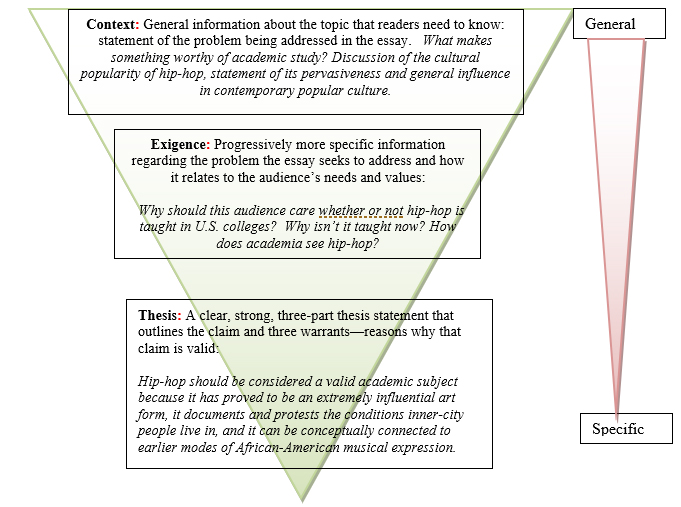Composition 03d: Organizing Argument Essays
Overview
Perhaps more than any other form of writing, argumentation depends on organization for its effectiveness. If an argument is disorganized, the audience will fail to grasp the logic of the piece and the writing will be unsuccessful—the audience will be unconvinced. Your essay must have an introduction that lays out background and establishes the exigence (or importance) of the subject. That introduction must also contain a clear and coherent thesis statement (see Chapter 05.3.1) that makes a strong and direct claim about your subject, along with providing warrants (reasons) for that claim. Subsequent paragraphs—several body paragraphs—in your argument must address, develop, and expand the claim made in your thesis statement. The essay should also conclude with a paragraph that reminds the audience of the importance of the subject to their lives, their values, and their interests.
Multipart Structure: A Convenient Argument Template
One of the most popular organizational schemes for basic arguments is multipart structure. This is, as one might expect, a method of organization that divides the argument into distinct parts. You might have heard of or even used this argument structure before; some high schools teach multipart structure as the “five paragraph essay” or the “five-part theme.” Nothing requires that a multipart-structured essay have five parts; some multipart essays have three parts (for simple arguments) or many parts (for longer, more complicated arguments).
A simple example of multipart structure (assuming a 3 part multipart thesis) is below:
- Introduction
- Body Section I
- Body Section II
- Body Section III
- Conclusion
This organizational approach allows the writer to accomplish three primary tasks in the argument: introducing the topic and the writing’s objective, developing claims and evidence, and concluding / restating the writing’s purpose.
The Introduction in an argument essay accomplishes three main things: it introduces the topic and provides essential background for the reader, it outlines the argument’s thesis statement or controlling idea, and it establishes a sense of the writing’s exigence or urgency—a sense of importance , relevance, and timeliness—for the reader. The thesis statement in a Five-Part essay is often a multipart thesis (see Chapter 05.3.1, Thesis Statements, for more information on constructing a good thesis). For more information on writing introductions, see Chapter 05.3.3, Introductions and Conclusions.
For purposes of this discussion, we’ll use the following three-part multipart thesis as an example:
Hip-hop should be considered a valid academic subject because it has proved to be an extremely influential art form, it documents and protests the conditions inner-city people live in, and it can be conceptually or aesthetically connected to earlier modes of African-American musical expression.
Introductions usually start with relatively general information about the problem, situation, or debate that the argument essay is addressing, and build toward more narrow and specific information, ending with the essay’s thesis. So the basic organization of an argumentative introduction looks something like this:

Body sections are often organized in a similar general-to-specific manner as an introduction paragraph, but with the body paragraph beginning with a topic sentence that relates directly to part of the thesis statement: one of the “three parts” of the three-part thesis.
The essay’s conclusion is a way to not only sum up or restate what was said in the body of the essay (again as it relates to the essay’s thesis statement), but also a way to reinforce the sense of exigence or “so what” for the reader.
